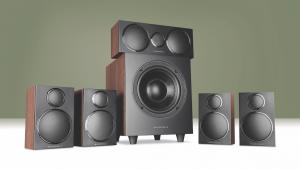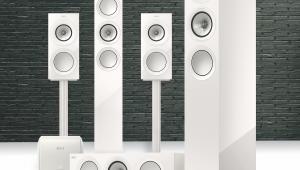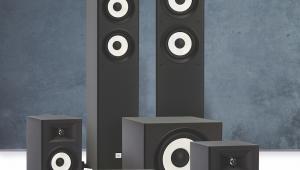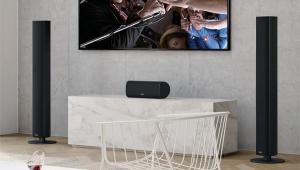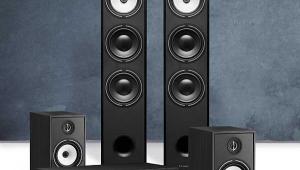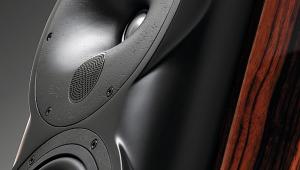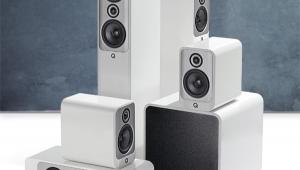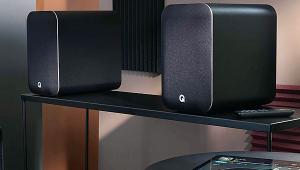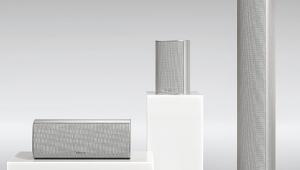Cambridge Audio Aero 5.1 review

 Cambridge Audio is probably best known at the moment for its popular Minx compact speaker range, which uses Balanced Mode Radiator (BMR) drivers to generate a large soundstage that belies their diddy dimensions, and the success of BMRs inside the Minx models has led the boffins at Cambridge Audio’s London research centre to ponder how they could be implemented inside bigger speakers. The result is Aero, a range of four new designs that combine BMR drivers with conventional cone diaphragms.
Cambridge Audio is probably best known at the moment for its popular Minx compact speaker range, which uses Balanced Mode Radiator (BMR) drivers to generate a large soundstage that belies their diddy dimensions, and the success of BMRs inside the Minx models has led the boffins at Cambridge Audio’s London research centre to ponder how they could be implemented inside bigger speakers. The result is Aero, a range of four new designs that combine BMR drivers with conventional cone diaphragms.
These BMR drivers take the place of traditional tweeters. This, reckons Cambridge Audio, gives the Aeros several advantages over competitors. Firstly, the crossover between the BMR and the bass driver happens at 250Hz, lower than the usual 3kHz where the human ear is more sensitive to any differences between the two.
Because Aero avoids this critical crossover frequency, it theoretically results in clearer, more coherent audio. And because the BMR drivers handle everything above 250Hz, the conventional cones can therefore focus on producing bass frequencies.
Another benefit of BMR-based speakers is that you can be less fussy about where they’re placed. Regular tweeters create sound with a pistonic in-out motion, but BMRs combine this movement with surface vibration to offer wider dispersion – which could be useful in rooms with an unconventional layout.
System setupOn test here is a configuration that deploys a £350 pair of Aero 2 bookshelf speakers at the front, alongside the £250 Aero 5 centre, a pair of Aero 3 surrounds (£300) and the £450 Aero 9 subwoofer. You can swap the Aero 2s for Aero 6 floorstanders (£650 a pair) if you’re feeling flush.
The Aero 2 fronts are fairly chunky for bookshelf speakers, particularly depth-wise – I’d recommend investing in some good quality stands. Granted, they aren’t the most aesthetically adventurous speakers around, but they have a neutrality that should play well in most living/cinema rooms. The lines are straight and clean and the plug-fixed black cloth grille on the front keeps everything low key. Behind it, rubber surrounds frame the BMR and single 6in cone. Overall build quality seems excellent, especially considering the relatively affordable price. The centre channel enclosure employs one 2in BMR flanked by 5.25in bass units.
Versatility is the key word when it comes to the Aero 3 surrounds. Their two opposing 4in BMR drivers allow you to use them either as bipoles in a 5.1 setup, or as dual monopoles in a 7.1 setup, where one driver handles surround information and the other plays the surround-back channel. Two sets of binding posts on the rear make this possible.
The stocky, cube-shaped Aero 9 subwoofer packs a 500W Class D amplifier that drives a 10in front-firing driver, backed up by a passive down-firing radiator. On the rear are volume and crossover dials, a phase inversion switch, and stereo and LFE phono inputs.
 Superheroic sonics
Superheroic sonics
After introducing the Aero array to my Onkyo AVR and Oppo BD deck, it took control of my test room with real panache. From the moment Eiffel 65’s Blue kicks in over the Marvel logo at the beginning of Iron Man 3, it was clear the setup meant business – the deep synth bassline, silky hi-hats and euro-pop vocals immediately grabbed my attention.
During the movie’s spectacular action scenes, the sound was big, powerful, exciting and all the other adjectives you’d expect from dedicated home cinema speakers. But what’s really impressive is how effortlessly and cohesively it filled my room with sound, something I attribute to the BMR drivers.
During the helicopter missile attack that obliterates Tony Stark’s home, they create a vast, voluminous soundstage where explosions, crashing debris and music flood into the room and submerge you. From every channel comes a wave of sound that links up with the others to complete a tightly-integrated, 360-degree soundfield. This means you're soon immersed in the story – with smooth interaction between channels, tonal uniformity and a lack of harshness at high volumes, there’s nothing here that’ll yank you back into the real world.
There’s no real weak link, either. The surrounds handle deep bass and high-frequency details as competently as the fronts, and the entire package seems remarkably powerful. The first missile slammed into Stark's house with a sustained rumble, accompanied by a hefty midrange. And as more ordnance pummels the superhero's pad, the sub shows off its slam and agility.
The woofer does, however, require thoughtful setup as it can quite easily swamp the soundstage when turned up too high. I was also slightly troubled when it started rattling wildly during certain parts of the movie. This may have been a fault with my sample, but does highlight how much raw power the cabinet has to contain.
High frequencies sound as light and airy as this system's chocolate bar namesake. Shattering glass cuts through the chaos clearly, while the bleeps and whirring noises as Stark suits up are rendered with impressive clarity. I have heard cleaner and more insightful detail from conventional tweeters, however.
Multichannel maestroSwitching to music, Cambridge Audio's 5.1 setup proves nicely adept. The title track of Roxy Music’s Avalon on Super Audio CD (a re-mastered 5.1 mix) has a vibrant energy, with precise timing and accurate positioning of instruments within its multichannel soundstage. Warm guitars and saxophones drift in and out of the mix, intertwining with percussion and electronic swells.
This commanding performance with movies and music makes Aero a superior speaker system. The BMR drivers help deliver a big, cohesive 5.1 soundstage that fills a room better than most packages at this price, while its considerable muscle will leave you invigorated and entertained. It’s not quite the last word in detail reproduction, but on the whole this is a sweet-sounding treat that fans of immersive surround sound should unwrap with gusto.
Specification
Aero 2 bookshelf speaker
Drive units: 1 x 2in BMR driver; 1 x 6.5in bass driver
Enclosure: Front-ported
Frequency response: 40Hz-22kHz
Sensitivity: 90dB
Power handling: 25-120W
Dimensions: 203(w) x 370(h) x 311(d)mm
Weight: 6.8kg
Aero 3 surround speaker
Drive units: 2 x 4in BMR drivers
Enclosure: Sealed
Frequency response: 80Hz-22kHz
Sensitivity: 88dB
Power handling: 25-120W
Dimensions: 461(w) x 180(h) x 151(d)mm
Weight: 4.8kg
Aero 5 centre speaker
Drive units: 1 x 2in BMR driver; 2 x 5.25in bass drivers
Enclosure: Sealed
Frequency response: 50Hz-22kHz
Sensitivity: 90
Power handling: 25-120W
Dimensions: 430(w) x 150(h) x 208(d)mm
Weight: 6.1kg
Aero 9 subwoofer
Drive units: 1 x 10in front-firing subwoofer; 1 x 10in down-firing ABR
Enclosure: Sealed
Frequency response: 21Hz-200Hz
On board power: 500W
Remote control: No
Dimensions: 330(w) x 340(h) x 355(d)mm
Weight: 11.7kg
Connections: Stereo line input; LFE input
 |
Home Cinema Choice #351 is on sale now, featuring: Samsung S95D flagship OLED TV; Ascendo loudspeakers; Pioneer VSA-LX805 AV receiver; UST projector roundup; 2024’s summer movies; Conan 4K; and more
|




